Resource and Talent Planning in the UK Labour Market Report
VerifiedAdded on 2020/10/22
|7
|1918
|181
Report
AI Summary
This report provides an analysis of resource and talent planning within the UK labour market, focusing on the year 2019. It begins with an overview of the labour market, including employment rates, unemployment statistics, and economic inactivity. The report highlights the challenges faced by graduate employability, such as the need for flexible policies and economic downturns, lack of confidence, and the impact of international students. It also discusses the importance of skill development programs, training initiatives, and collaboration between private organizations and the government to address these challenges and reduce unemployment. The report concludes by emphasizing the significance of effective recruitment, selection processes, and skill development in the success of organizations.
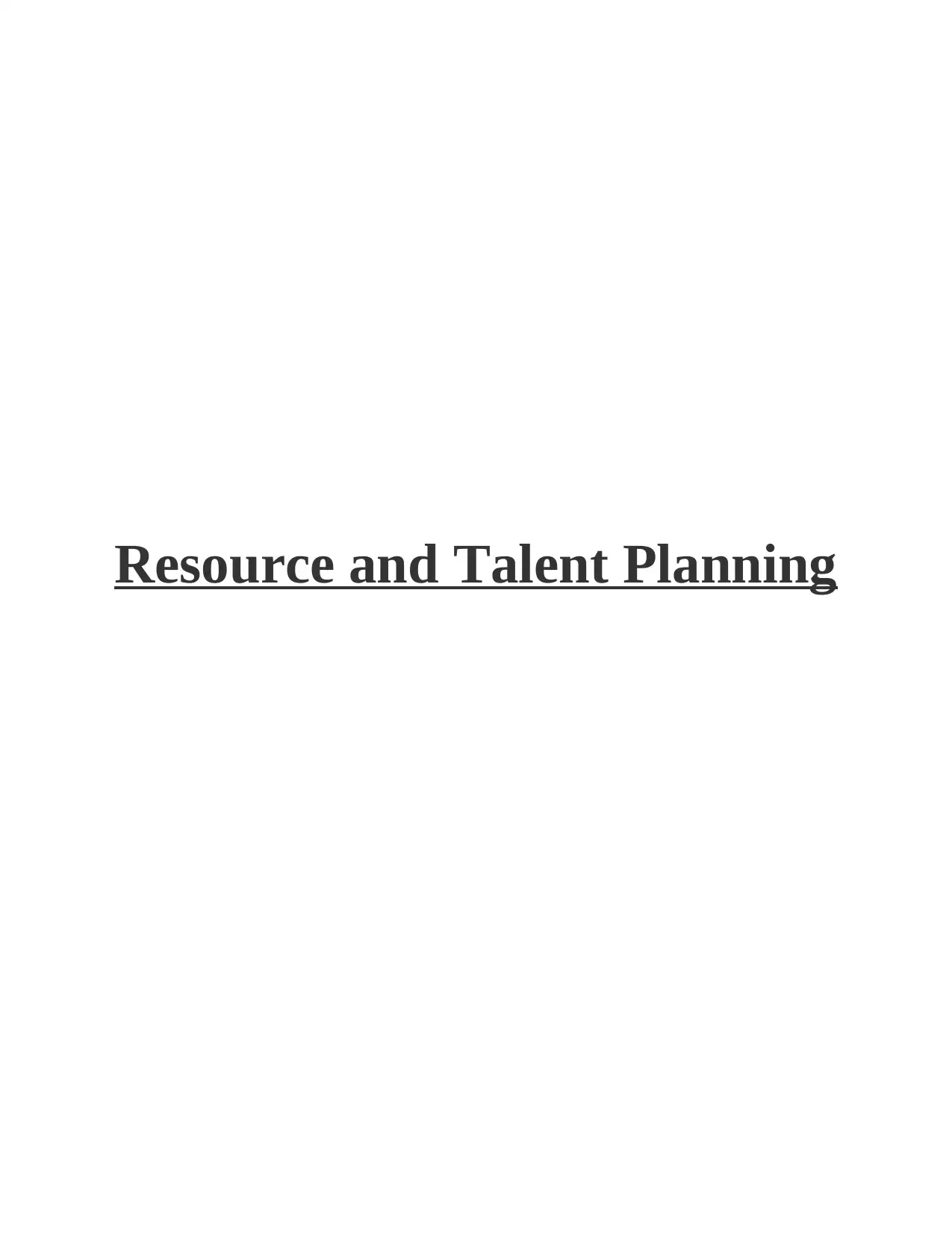
Resource and Talent Planning
Paraphrase This Document
Need a fresh take? Get an instant paraphrase of this document with our AI Paraphraser
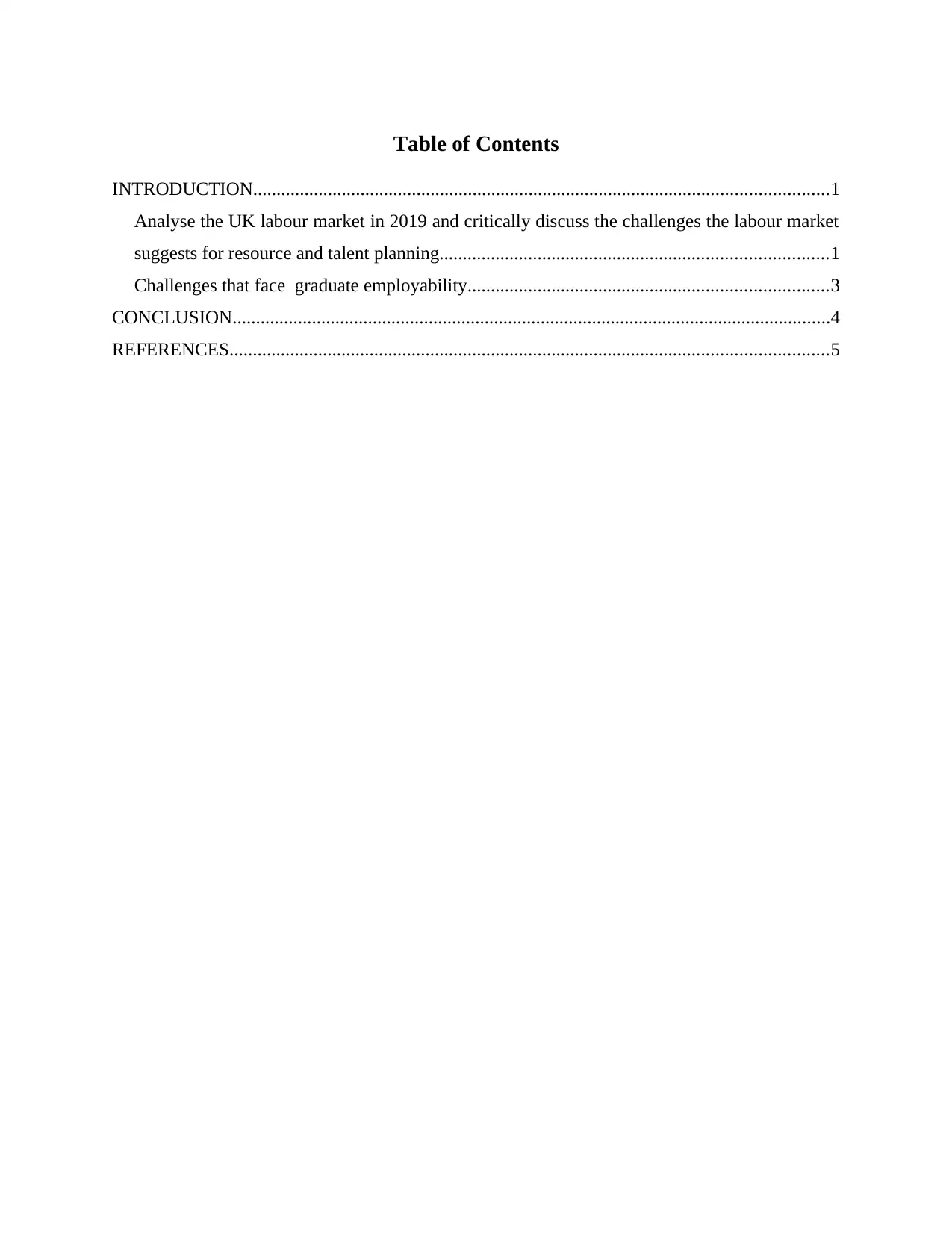
Table of Contents
INTRODUCTION...........................................................................................................................1
Analyse the UK labour market in 2019 and critically discuss the challenges the labour market
suggests for resource and talent planning...................................................................................1
Challenges that face graduate employability.............................................................................3
CONCLUSION................................................................................................................................4
REFERENCES................................................................................................................................5
INTRODUCTION...........................................................................................................................1
Analyse the UK labour market in 2019 and critically discuss the challenges the labour market
suggests for resource and talent planning...................................................................................1
Challenges that face graduate employability.............................................................................3
CONCLUSION................................................................................................................................4
REFERENCES................................................................................................................................5
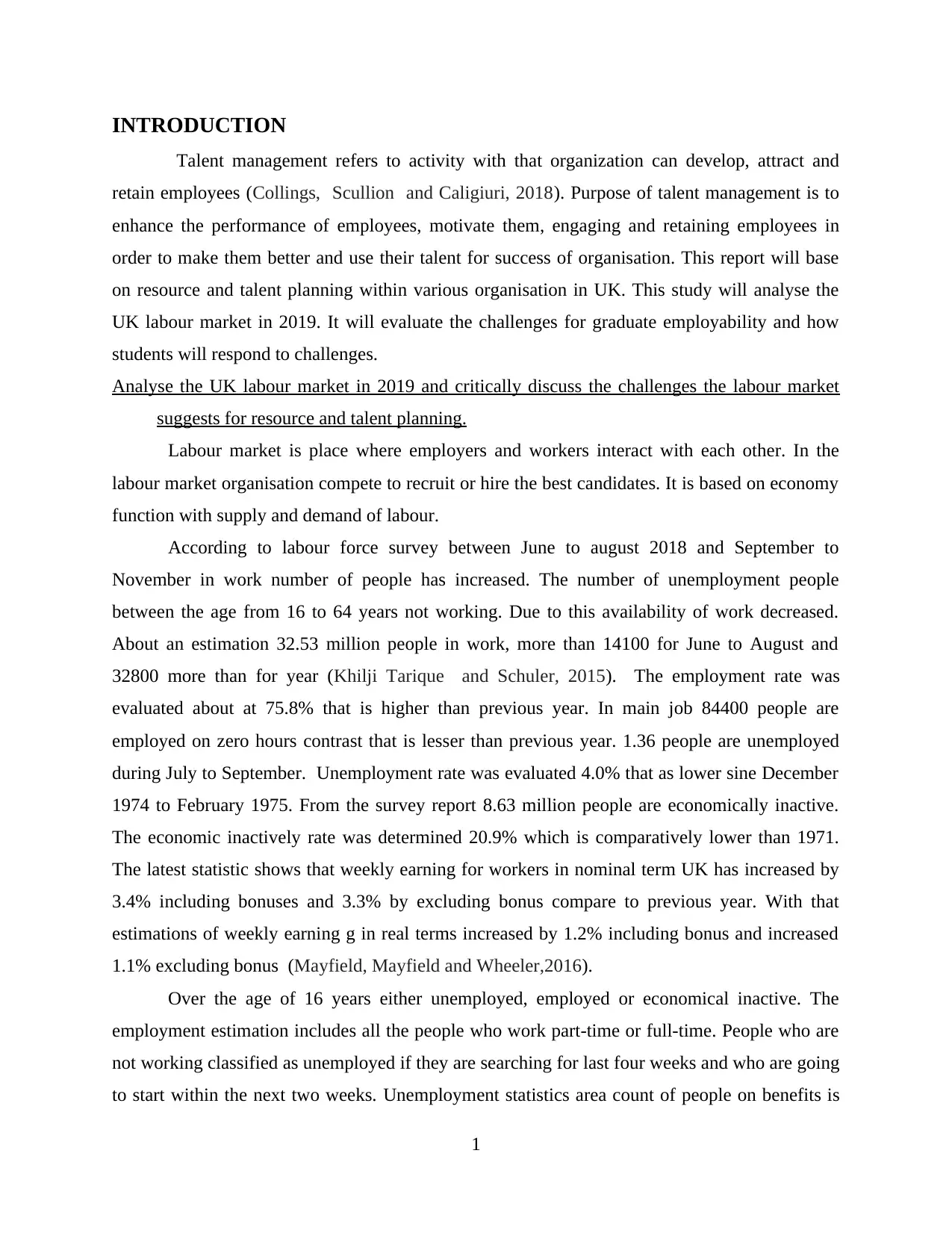
INTRODUCTION
Talent management refers to activity with that organization can develop, attract and
retain employees (Collings, Scullion and Caligiuri, 2018). Purpose of talent management is to
enhance the performance of employees, motivate them, engaging and retaining employees in
order to make them better and use their talent for success of organisation. This report will base
on resource and talent planning within various organisation in UK. This study will analyse the
UK labour market in 2019. It will evaluate the challenges for graduate employability and how
students will respond to challenges.
Analyse the UK labour market in 2019 and critically discuss the challenges the labour market
suggests for resource and talent planning.
Labour market is place where employers and workers interact with each other. In the
labour market organisation compete to recruit or hire the best candidates. It is based on economy
function with supply and demand of labour.
According to labour force survey between June to august 2018 and September to
November in work number of people has increased. The number of unemployment people
between the age from 16 to 64 years not working. Due to this availability of work decreased.
About an estimation 32.53 million people in work, more than 14100 for June to August and
32800 more than for year (Khilji Tarique and Schuler, 2015). The employment rate was
evaluated about at 75.8% that is higher than previous year. In main job 84400 people are
employed on zero hours contrast that is lesser than previous year. 1.36 people are unemployed
during July to September. Unemployment rate was evaluated 4.0% that as lower sine December
1974 to February 1975. From the survey report 8.63 million people are economically inactive.
The economic inactively rate was determined 20.9% which is comparatively lower than 1971.
The latest statistic shows that weekly earning for workers in nominal term UK has increased by
3.4% including bonuses and 3.3% by excluding bonus compare to previous year. With that
estimations of weekly earning g in real terms increased by 1.2% including bonus and increased
1.1% excluding bonus (Mayfield, Mayfield and Wheeler,2016).
Over the age of 16 years either unemployed, employed or economical inactive. The
employment estimation includes all the people who work part-time or full-time. People who are
not working classified as unemployed if they are searching for last four weeks and who are going
to start within the next two weeks. Unemployment statistics area count of people on benefits is
1
Talent management refers to activity with that organization can develop, attract and
retain employees (Collings, Scullion and Caligiuri, 2018). Purpose of talent management is to
enhance the performance of employees, motivate them, engaging and retaining employees in
order to make them better and use their talent for success of organisation. This report will base
on resource and talent planning within various organisation in UK. This study will analyse the
UK labour market in 2019. It will evaluate the challenges for graduate employability and how
students will respond to challenges.
Analyse the UK labour market in 2019 and critically discuss the challenges the labour market
suggests for resource and talent planning.
Labour market is place where employers and workers interact with each other. In the
labour market organisation compete to recruit or hire the best candidates. It is based on economy
function with supply and demand of labour.
According to labour force survey between June to august 2018 and September to
November in work number of people has increased. The number of unemployment people
between the age from 16 to 64 years not working. Due to this availability of work decreased.
About an estimation 32.53 million people in work, more than 14100 for June to August and
32800 more than for year (Khilji Tarique and Schuler, 2015). The employment rate was
evaluated about at 75.8% that is higher than previous year. In main job 84400 people are
employed on zero hours contrast that is lesser than previous year. 1.36 people are unemployed
during July to September. Unemployment rate was evaluated 4.0% that as lower sine December
1974 to February 1975. From the survey report 8.63 million people are economically inactive.
The economic inactively rate was determined 20.9% which is comparatively lower than 1971.
The latest statistic shows that weekly earning for workers in nominal term UK has increased by
3.4% including bonuses and 3.3% by excluding bonus compare to previous year. With that
estimations of weekly earning g in real terms increased by 1.2% including bonus and increased
1.1% excluding bonus (Mayfield, Mayfield and Wheeler,2016).
Over the age of 16 years either unemployed, employed or economical inactive. The
employment estimation includes all the people who work part-time or full-time. People who are
not working classified as unemployed if they are searching for last four weeks and who are going
to start within the next two weeks. Unemployment statistics area count of people on benefits is
1
⊘ This is a preview!⊘
Do you want full access?
Subscribe today to unlock all pages.

Trusted by 1+ million students worldwide
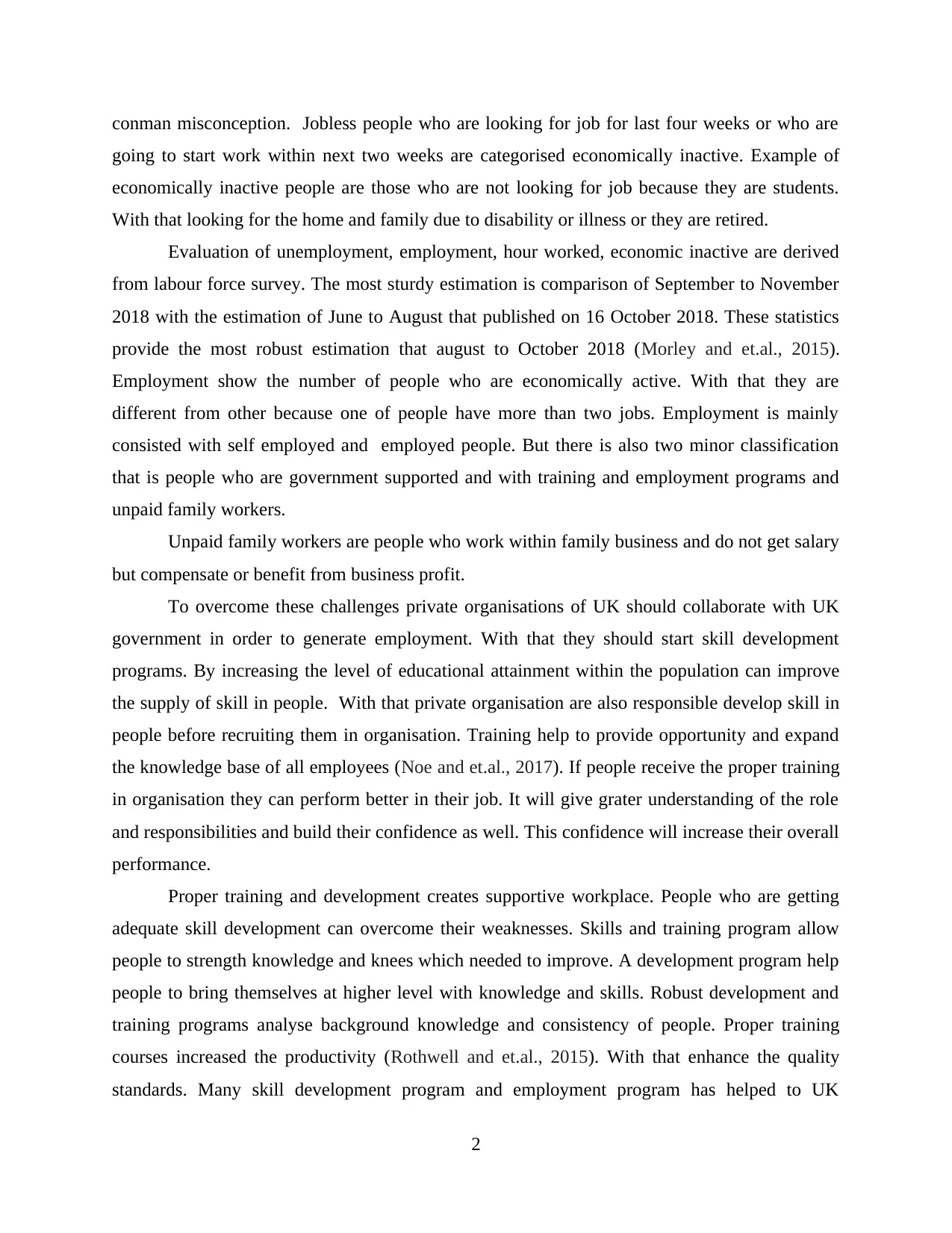
conman misconception. Jobless people who are looking for job for last four weeks or who are
going to start work within next two weeks are categorised economically inactive. Example of
economically inactive people are those who are not looking for job because they are students.
With that looking for the home and family due to disability or illness or they are retired.
Evaluation of unemployment, employment, hour worked, economic inactive are derived
from labour force survey. The most sturdy estimation is comparison of September to November
2018 with the estimation of June to August that published on 16 October 2018. These statistics
provide the most robust estimation that august to October 2018 (Morley and et.al., 2015).
Employment show the number of people who are economically active. With that they are
different from other because one of people have more than two jobs. Employment is mainly
consisted with self employed and employed people. But there is also two minor classification
that is people who are government supported and with training and employment programs and
unpaid family workers.
Unpaid family workers are people who work within family business and do not get salary
but compensate or benefit from business profit.
To overcome these challenges private organisations of UK should collaborate with UK
government in order to generate employment. With that they should start skill development
programs. By increasing the level of educational attainment within the population can improve
the supply of skill in people. With that private organisation are also responsible develop skill in
people before recruiting them in organisation. Training help to provide opportunity and expand
the knowledge base of all employees (Noe and et.al., 2017). If people receive the proper training
in organisation they can perform better in their job. It will give grater understanding of the role
and responsibilities and build their confidence as well. This confidence will increase their overall
performance.
Proper training and development creates supportive workplace. People who are getting
adequate skill development can overcome their weaknesses. Skills and training program allow
people to strength knowledge and knees which needed to improve. A development program help
people to bring themselves at higher level with knowledge and skills. Robust development and
training programs analyse background knowledge and consistency of people. Proper training
courses increased the productivity (Rothwell and et.al., 2015). With that enhance the quality
standards. Many skill development program and employment program has helped to UK
2
going to start work within next two weeks are categorised economically inactive. Example of
economically inactive people are those who are not looking for job because they are students.
With that looking for the home and family due to disability or illness or they are retired.
Evaluation of unemployment, employment, hour worked, economic inactive are derived
from labour force survey. The most sturdy estimation is comparison of September to November
2018 with the estimation of June to August that published on 16 October 2018. These statistics
provide the most robust estimation that august to October 2018 (Morley and et.al., 2015).
Employment show the number of people who are economically active. With that they are
different from other because one of people have more than two jobs. Employment is mainly
consisted with self employed and employed people. But there is also two minor classification
that is people who are government supported and with training and employment programs and
unpaid family workers.
Unpaid family workers are people who work within family business and do not get salary
but compensate or benefit from business profit.
To overcome these challenges private organisations of UK should collaborate with UK
government in order to generate employment. With that they should start skill development
programs. By increasing the level of educational attainment within the population can improve
the supply of skill in people. With that private organisation are also responsible develop skill in
people before recruiting them in organisation. Training help to provide opportunity and expand
the knowledge base of all employees (Noe and et.al., 2017). If people receive the proper training
in organisation they can perform better in their job. It will give grater understanding of the role
and responsibilities and build their confidence as well. This confidence will increase their overall
performance.
Proper training and development creates supportive workplace. People who are getting
adequate skill development can overcome their weaknesses. Skills and training program allow
people to strength knowledge and knees which needed to improve. A development program help
people to bring themselves at higher level with knowledge and skills. Robust development and
training programs analyse background knowledge and consistency of people. Proper training
courses increased the productivity (Rothwell and et.al., 2015). With that enhance the quality
standards. Many skill development program and employment program has helped to UK
2
Paraphrase This Document
Need a fresh take? Get an instant paraphrase of this document with our AI Paraphraser
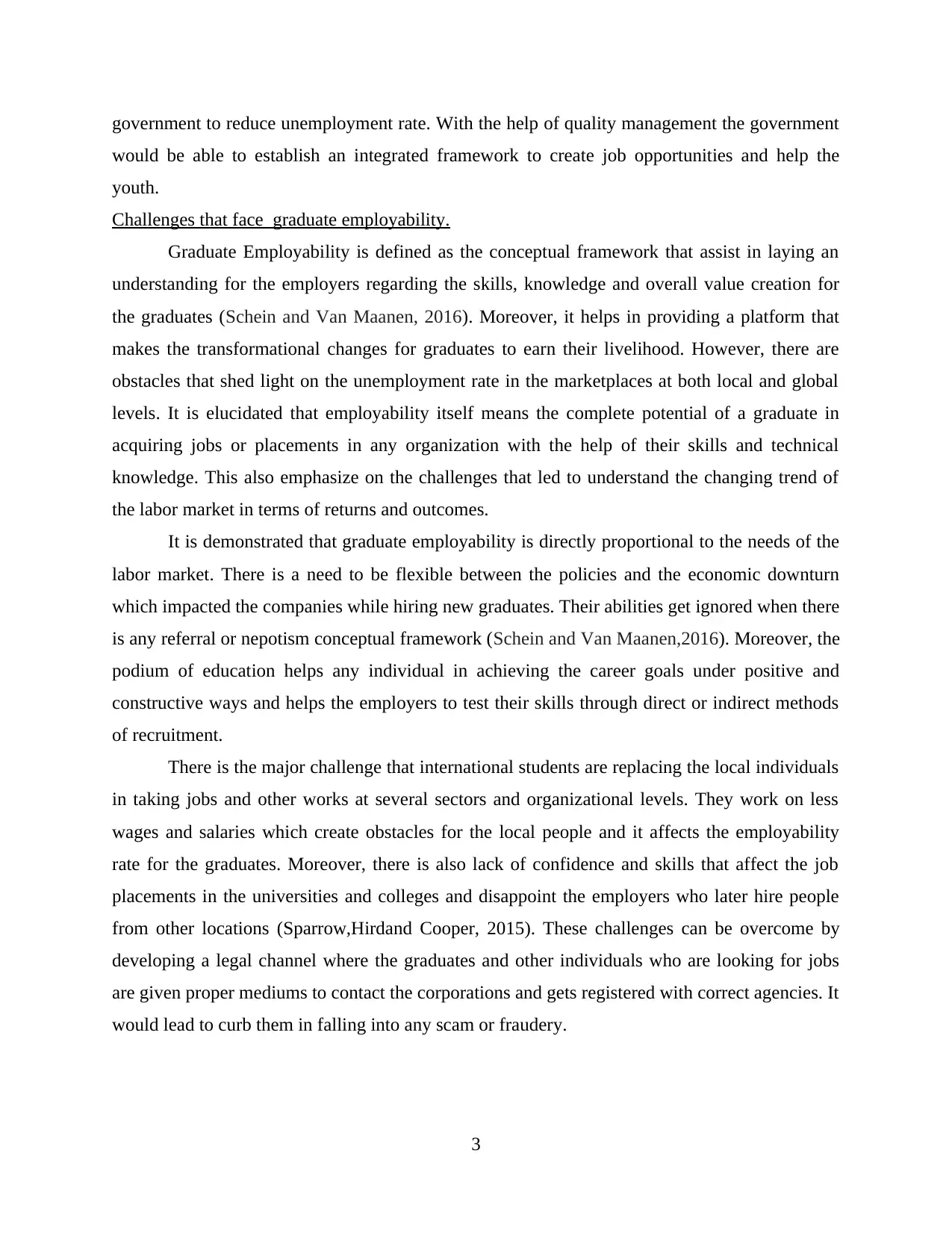
government to reduce unemployment rate. With the help of quality management the government
would be able to establish an integrated framework to create job opportunities and help the
youth.
Challenges that face graduate employability.
Graduate Employability is defined as the conceptual framework that assist in laying an
understanding for the employers regarding the skills, knowledge and overall value creation for
the graduates (Schein and Van Maanen, 2016). Moreover, it helps in providing a platform that
makes the transformational changes for graduates to earn their livelihood. However, there are
obstacles that shed light on the unemployment rate in the marketplaces at both local and global
levels. It is elucidated that employability itself means the complete potential of a graduate in
acquiring jobs or placements in any organization with the help of their skills and technical
knowledge. This also emphasize on the challenges that led to understand the changing trend of
the labor market in terms of returns and outcomes.
It is demonstrated that graduate employability is directly proportional to the needs of the
labor market. There is a need to be flexible between the policies and the economic downturn
which impacted the companies while hiring new graduates. Their abilities get ignored when there
is any referral or nepotism conceptual framework (Schein and Van Maanen,2016). Moreover, the
podium of education helps any individual in achieving the career goals under positive and
constructive ways and helps the employers to test their skills through direct or indirect methods
of recruitment.
There is the major challenge that international students are replacing the local individuals
in taking jobs and other works at several sectors and organizational levels. They work on less
wages and salaries which create obstacles for the local people and it affects the employability
rate for the graduates. Moreover, there is also lack of confidence and skills that affect the job
placements in the universities and colleges and disappoint the employers who later hire people
from other locations (Sparrow,Hirdand Cooper, 2015). These challenges can be overcome by
developing a legal channel where the graduates and other individuals who are looking for jobs
are given proper mediums to contact the corporations and gets registered with correct agencies. It
would lead to curb them in falling into any scam or fraudery.
3
would be able to establish an integrated framework to create job opportunities and help the
youth.
Challenges that face graduate employability.
Graduate Employability is defined as the conceptual framework that assist in laying an
understanding for the employers regarding the skills, knowledge and overall value creation for
the graduates (Schein and Van Maanen, 2016). Moreover, it helps in providing a platform that
makes the transformational changes for graduates to earn their livelihood. However, there are
obstacles that shed light on the unemployment rate in the marketplaces at both local and global
levels. It is elucidated that employability itself means the complete potential of a graduate in
acquiring jobs or placements in any organization with the help of their skills and technical
knowledge. This also emphasize on the challenges that led to understand the changing trend of
the labor market in terms of returns and outcomes.
It is demonstrated that graduate employability is directly proportional to the needs of the
labor market. There is a need to be flexible between the policies and the economic downturn
which impacted the companies while hiring new graduates. Their abilities get ignored when there
is any referral or nepotism conceptual framework (Schein and Van Maanen,2016). Moreover, the
podium of education helps any individual in achieving the career goals under positive and
constructive ways and helps the employers to test their skills through direct or indirect methods
of recruitment.
There is the major challenge that international students are replacing the local individuals
in taking jobs and other works at several sectors and organizational levels. They work on less
wages and salaries which create obstacles for the local people and it affects the employability
rate for the graduates. Moreover, there is also lack of confidence and skills that affect the job
placements in the universities and colleges and disappoint the employers who later hire people
from other locations (Sparrow,Hirdand Cooper, 2015). These challenges can be overcome by
developing a legal channel where the graduates and other individuals who are looking for jobs
are given proper mediums to contact the corporations and gets registered with correct agencies. It
would lead to curb them in falling into any scam or fraudery.
3
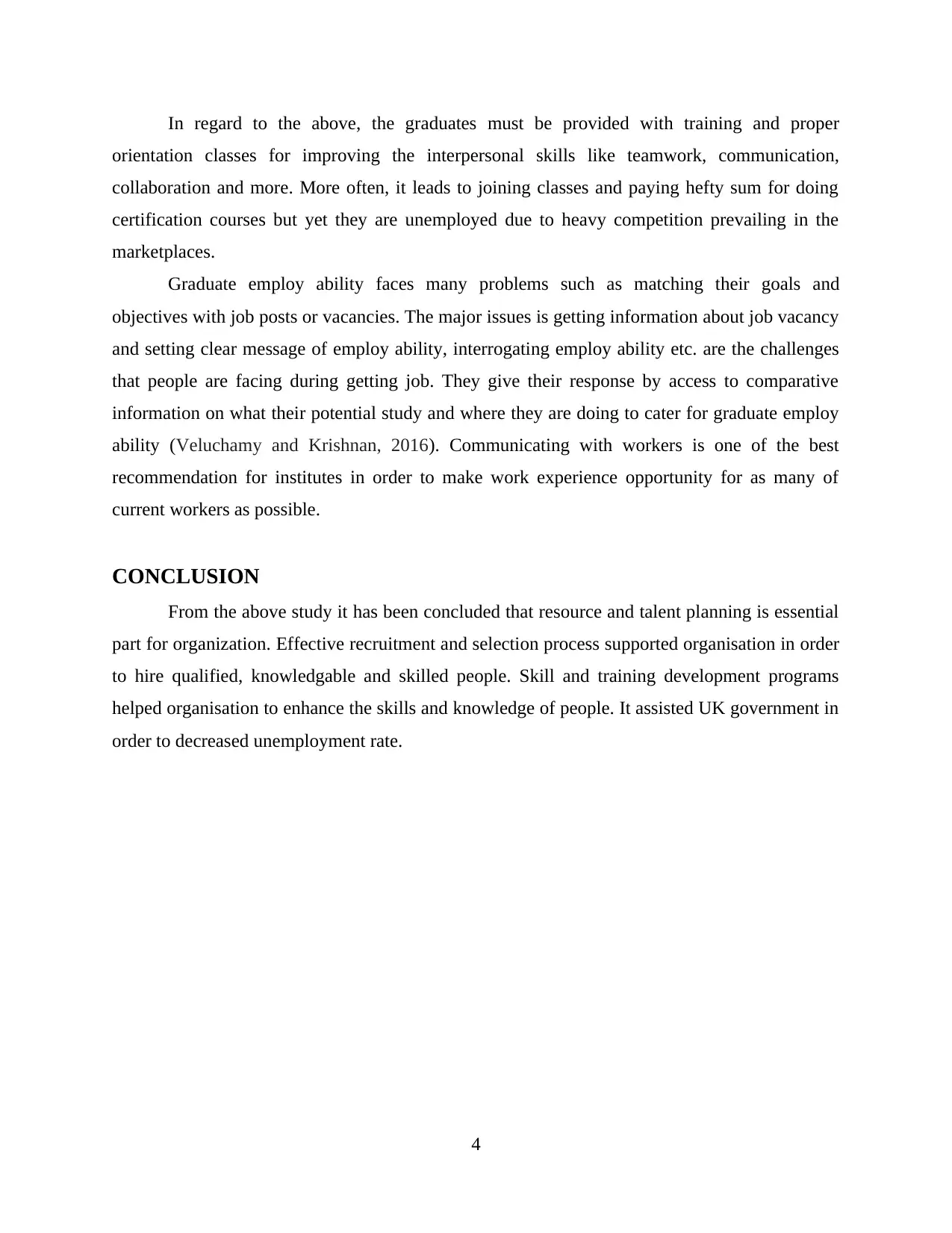
In regard to the above, the graduates must be provided with training and proper
orientation classes for improving the interpersonal skills like teamwork, communication,
collaboration and more. More often, it leads to joining classes and paying hefty sum for doing
certification courses but yet they are unemployed due to heavy competition prevailing in the
marketplaces.
Graduate employ ability faces many problems such as matching their goals and
objectives with job posts or vacancies. The major issues is getting information about job vacancy
and setting clear message of employ ability, interrogating employ ability etc. are the challenges
that people are facing during getting job. They give their response by access to comparative
information on what their potential study and where they are doing to cater for graduate employ
ability (Veluchamy and Krishnan, 2016). Communicating with workers is one of the best
recommendation for institutes in order to make work experience opportunity for as many of
current workers as possible.
CONCLUSION
From the above study it has been concluded that resource and talent planning is essential
part for organization. Effective recruitment and selection process supported organisation in order
to hire qualified, knowledgable and skilled people. Skill and training development programs
helped organisation to enhance the skills and knowledge of people. It assisted UK government in
order to decreased unemployment rate.
4
orientation classes for improving the interpersonal skills like teamwork, communication,
collaboration and more. More often, it leads to joining classes and paying hefty sum for doing
certification courses but yet they are unemployed due to heavy competition prevailing in the
marketplaces.
Graduate employ ability faces many problems such as matching their goals and
objectives with job posts or vacancies. The major issues is getting information about job vacancy
and setting clear message of employ ability, interrogating employ ability etc. are the challenges
that people are facing during getting job. They give their response by access to comparative
information on what their potential study and where they are doing to cater for graduate employ
ability (Veluchamy and Krishnan, 2016). Communicating with workers is one of the best
recommendation for institutes in order to make work experience opportunity for as many of
current workers as possible.
CONCLUSION
From the above study it has been concluded that resource and talent planning is essential
part for organization. Effective recruitment and selection process supported organisation in order
to hire qualified, knowledgable and skilled people. Skill and training development programs
helped organisation to enhance the skills and knowledge of people. It assisted UK government in
order to decreased unemployment rate.
4
⊘ This is a preview!⊘
Do you want full access?
Subscribe today to unlock all pages.

Trusted by 1+ million students worldwide
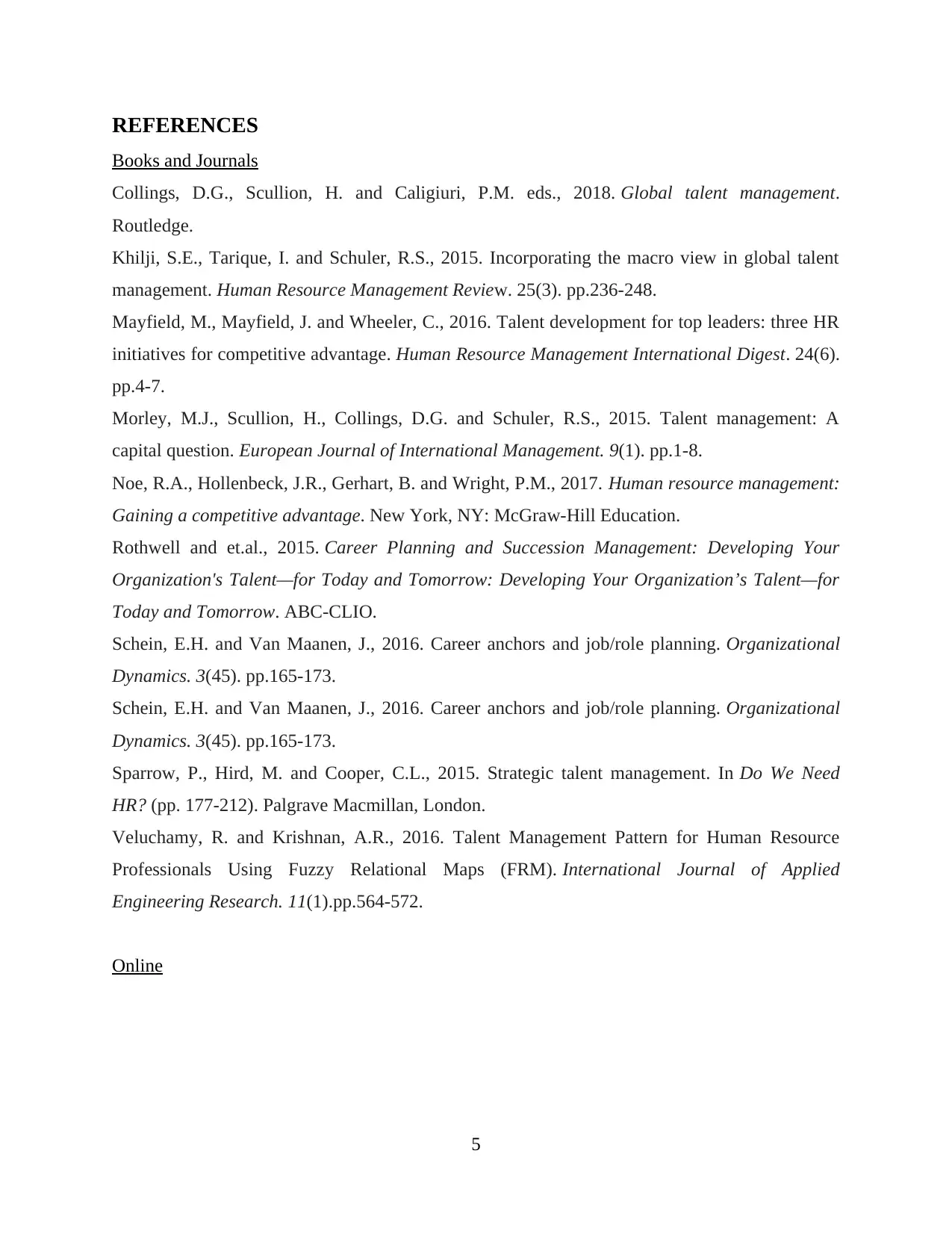
REFERENCES
Books and Journals
Collings, D.G., Scullion, H. and Caligiuri, P.M. eds., 2018. Global talent management.
Routledge.
Khilji, S.E., Tarique, I. and Schuler, R.S., 2015. Incorporating the macro view in global talent
management. Human Resource Management Review. 25(3). pp.236-248.
Mayfield, M., Mayfield, J. and Wheeler, C., 2016. Talent development for top leaders: three HR
initiatives for competitive advantage. Human Resource Management International Digest. 24(6).
pp.4-7.
Morley, M.J., Scullion, H., Collings, D.G. and Schuler, R.S., 2015. Talent management: A
capital question. European Journal of International Management. 9(1). pp.1-8.
Noe, R.A., Hollenbeck, J.R., Gerhart, B. and Wright, P.M., 2017. Human resource management:
Gaining a competitive advantage. New York, NY: McGraw-Hill Education.
Rothwell and et.al., 2015. Career Planning and Succession Management: Developing Your
Organization's Talent—for Today and Tomorrow: Developing Your Organization’s Talent—for
Today and Tomorrow. ABC-CLIO.
Schein, E.H. and Van Maanen, J., 2016. Career anchors and job/role planning. Organizational
Dynamics. 3(45). pp.165-173.
Schein, E.H. and Van Maanen, J., 2016. Career anchors and job/role planning. Organizational
Dynamics. 3(45). pp.165-173.
Sparrow, P., Hird, M. and Cooper, C.L., 2015. Strategic talent management. In Do We Need
HR? (pp. 177-212). Palgrave Macmillan, London.
Veluchamy, R. and Krishnan, A.R., 2016. Talent Management Pattern for Human Resource
Professionals Using Fuzzy Relational Maps (FRM). International Journal of Applied
Engineering Research. 11(1).pp.564-572.
Online
5
Books and Journals
Collings, D.G., Scullion, H. and Caligiuri, P.M. eds., 2018. Global talent management.
Routledge.
Khilji, S.E., Tarique, I. and Schuler, R.S., 2015. Incorporating the macro view in global talent
management. Human Resource Management Review. 25(3). pp.236-248.
Mayfield, M., Mayfield, J. and Wheeler, C., 2016. Talent development for top leaders: three HR
initiatives for competitive advantage. Human Resource Management International Digest. 24(6).
pp.4-7.
Morley, M.J., Scullion, H., Collings, D.G. and Schuler, R.S., 2015. Talent management: A
capital question. European Journal of International Management. 9(1). pp.1-8.
Noe, R.A., Hollenbeck, J.R., Gerhart, B. and Wright, P.M., 2017. Human resource management:
Gaining a competitive advantage. New York, NY: McGraw-Hill Education.
Rothwell and et.al., 2015. Career Planning and Succession Management: Developing Your
Organization's Talent—for Today and Tomorrow: Developing Your Organization’s Talent—for
Today and Tomorrow. ABC-CLIO.
Schein, E.H. and Van Maanen, J., 2016. Career anchors and job/role planning. Organizational
Dynamics. 3(45). pp.165-173.
Schein, E.H. and Van Maanen, J., 2016. Career anchors and job/role planning. Organizational
Dynamics. 3(45). pp.165-173.
Sparrow, P., Hird, M. and Cooper, C.L., 2015. Strategic talent management. In Do We Need
HR? (pp. 177-212). Palgrave Macmillan, London.
Veluchamy, R. and Krishnan, A.R., 2016. Talent Management Pattern for Human Resource
Professionals Using Fuzzy Relational Maps (FRM). International Journal of Applied
Engineering Research. 11(1).pp.564-572.
Online
5
1 out of 7
Related Documents
Your All-in-One AI-Powered Toolkit for Academic Success.
+13062052269
info@desklib.com
Available 24*7 on WhatsApp / Email
![[object Object]](/_next/static/media/star-bottom.7253800d.svg)
Unlock your academic potential
Copyright © 2020–2025 A2Z Services. All Rights Reserved. Developed and managed by ZUCOL.





